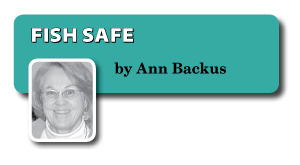by Ann Backus –
On Feb. 4, the 47′ Capt R M Chace began flooding off Chatham, MA. This story had a good ending. All four crewmembers donned survival suits and were rescued by personnel from the local Coast Guard station. The boat was dewatered and towed to port, the catch was offloaded, and the crew was fine.
But many flooding incidents in the Northeast do not end so well, according to 2000-2009 data compiled by Jennifer Lincoln and Devin Lucas for a November 2010 publication of the National Institute for Occupational Safety and Health (NIOSH).
According to the report, among all vessel disasters, the top two crisis-initiating events were flooding (12) and instability (12).

The multispecies groundfish fleet logged four flooding incidents, which accounted for 33% of groundfish vessel disasters. In total, 19 people died as a result of 12 groundfish vessel disasters during the survey period. In the
scallop fishery, there were 12 vessel disasters, two of which were due to flooding.
Water can enter a vessel three ways: through a breech in the hull usually caused by a collision; through a breech in the lazarette and packing around the propeller; and through open or insufficiently locked-down hatches and doors.
To address flooding issues, a NIOSH research team has designed three monitoring systems. The first is a hatch/door monitoring system that displays the status of hatch doors as “open,” “closed,” or “dogged closed.” Using this system, the captain can continuously monitor all of the vessel’s deck hatches and doors from the wheelhouse. This system is currently being tested on vessels in Alaska, and negotiations are underway to license a corporation in Oregon to build, market, and sell it.
Similar devices are being designed to monitor the lazarette compartment and water-tight compartments. The latter, called a slack tank monitor, keeps track of the amount of water in the hold and signals if the hold/watertight compartments are filling up. The benefit of this arrangement is that the hold status can be monitored without having to open the hatches.
A major disaster was averted with the Capt R M Chace, mentioned above, because crewmembers reportedly used the radio to notify the Coast Guard of the emergency before the situation became dire, had survival suits that fit them, and put them on.
Helping fishermen master these vital procedures is the goal of fishing vessel safety training sessions, and all fishermen should seek and obtain such training. Fishermen’s Partnership Support Services is now sponsoring training sessions throughout the region (see Guest Column, previous page). The next one is scheduled to take place in Sandwich, MA on March 22. For more information, visit the partnership’s website at <www.fishingpartnership.org>.
To be sure that your equipment is in good working order and your vessel is seaworthy, be sure to get your voluntary dockside exam. More information on how to schedule an exam is available online at <http://fishsafe.info>. Click on “Locate Examiners.”
Ann Backus, MS, is the director of outreach for the Harvard School of Public Health’s Department of Environmental Health in Boston, MA. She may be reached by phone at (617) 432-3327 or by e-mail at Ann Backus <abackus@hsph.harvard.edu>.
<< Back to Fishing Vessel Safety Page







